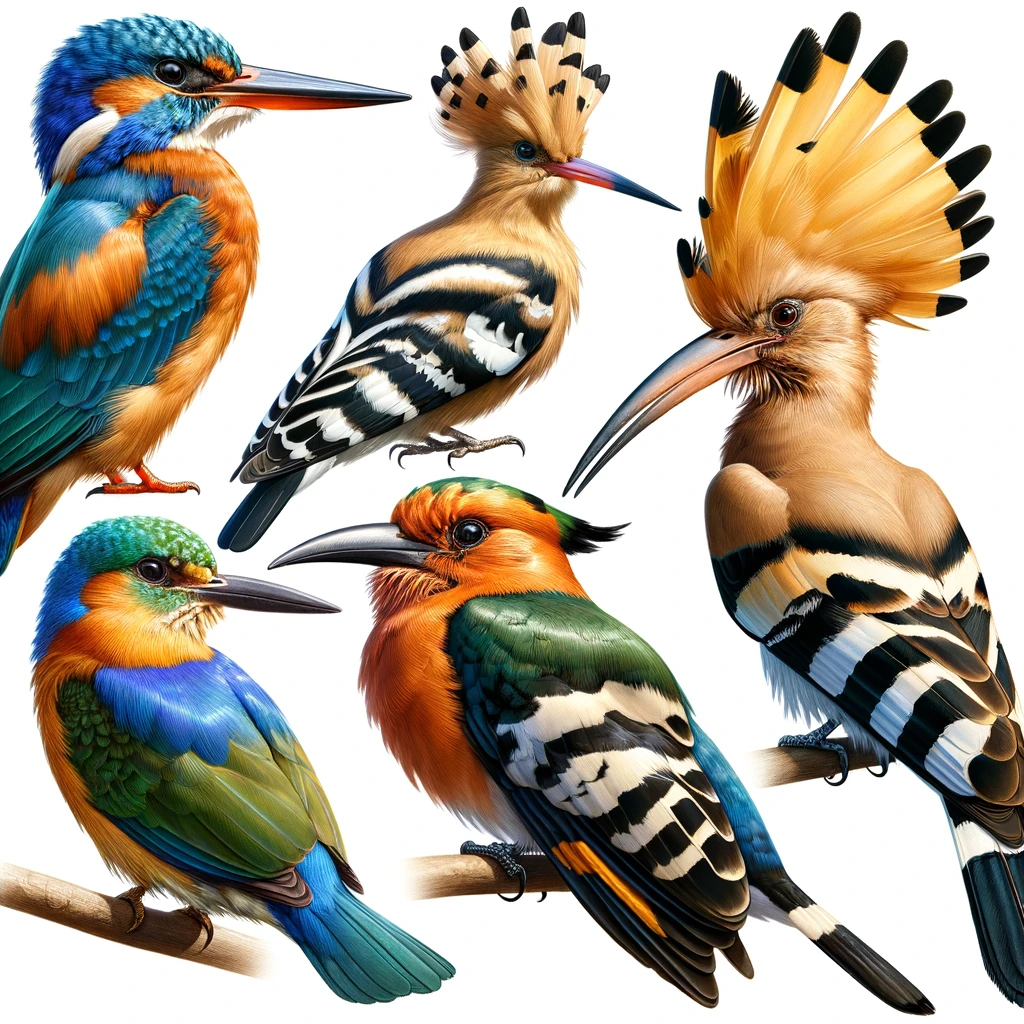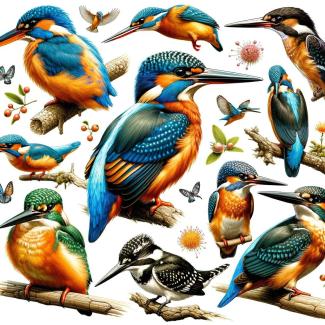
Containing kingfishers, bee-eaters, rollers, motmots, and todies, Coraciiformes represents a diverse order of small- to medium-sized near-passerine birds well adapted for aerial hunting. With over 200 extant species in 10 families, they boast nearly global distribution across warmer habitats in the Western Hemisphere, Europe, Africa, Asia, and Australasia.
Coraciiformes likely trace their origins back to the late Cretaceous era amidst the adaptive radiation unfolding among ancestral passeriform stock some 50 million years ago. Retaining robust feet suited for perching rather than clinging, but gaining modified bills for specialized hunting strategies, successive diverging Coraciiforme lineages exploited opening niche space partitioning food resources in forest canopies and open woodlands.
Today Coraciiformes display spectacular variation on a shared aerial insectivore theme - from African pygmy kingfishers to American motmots with outlandish racqueted tail streamers. Dazzling plumage not only facilitates camouflage amidst tropical brilliance but also social signaling and mate attraction in conspicuous bee-eaters, rollers, and relatives sporting turquoise carapaces amidst savanna canopies or along forest riverbanks worldwide.
Wherever found, Coraciiformes contribute irreplaceable flashes of color alongside critical ecological services sustaining balanced habitats across continents.
Characteristics
Physical Features
Coraciiformes exhibit a gradient of diminutive to larger forms across families - but generally remain small- to medium-sized near passerines with enlarged heads, short necks, sturdy feet, and wide gapes. Robust cone-shaped bills serve as versatile tools suited to capturing and dismembering insects as well as other small prey.
Barbets display distinctive bristles around wide mandibles while bee-eaters and rollers evolved finely serrated edges on longer slender bills that aid in gripping slippery insects. Kingfishers’ longer dagger-like forms specialize in spearing fish underwater. But all share piercing tips facilitating immobilizing prey. Sturdy feet with zygodactyl toes enable skillful perching and nest cavity excavation.
Colorful metallic plumes prevail - usually iridescent blues, turquoise, and chestnut browns that aid camouflage against forest or sand environments when at rest. Aerobatic aerialists like rollers and bee-eaters also sport elongated central tail feathers aiding intricate in-flight maneuvers. Such ostentation likely serves both camouflage when folded and social signaling purposes when fanned in displays.
Vivid hues enhance mate attraction performances but also conceal inert coraciiforms amidst densely patterned habitats.
Behavioral Traits
Primarily carnivorous, the vast majority of Coraciiformes consume insects captured during continuous short aerial sallies from exposed conspicuous perches surveying territories. Prey items span dragonflies, grasshoppers, butterflies, hymenopterans and more snatched via midair dexterity or gleaned directly from foliage. A few like motmots take small lizards or tree frogs as well.
Mated pairs engage in lively courtship chases and calls to confirm bonds frequently. Cavity nesting predominates in self-excavated earthen holes, termite mounds, or tree hollows. The tunnels shelter fragile white eggs lain atop remnant pellets until hatching after roughly 18-day incubation spans.
Reproduction and Lifespan
Monomorphic species mate continuously each season. But elaborate dimorphic male bee-eaters and rollers flash brilliant plumage in aerial gatherings while ranging more widely as less conspicuous females brood young alone. This facilitates maximizing reproductive attempts across wider areas monitored by traveling harems centered around quality nesting banks.
Altricial hatchlings require 3-5 weeks of parental care til fledging. Reported longevity remains poorly documented but likely averages under 5 years for most species. Though an impressive North American record documented an adult Belted Kingfisher nearly 24 years old!
Some extant families
Alcedinidae (river kingfishers)
The over 100 kingfisher species occupy freshwater habitats on all continents save Antarctica. Stocky profiles, dagger bills, and variable coloration suit them for diving to spear small fish. Some like the Belted Kingfisher tolerate cold temperate climates while most thriving the topics.
Meropidae (bee-eaters)
The 26 bee-eater species reside across Africa, Asia, Europe, and Australia tracking insects most actively in open habitats like grasslands and deserts along forest verges. Slender profiles with elongated wings, tail streamers, and serrated bills serve the aerobatic pursuit of swarming hymenopterans.
Coraciidae (rollers)
The 12 roller species frequent similar African and Eurasian habitats to related bee-eaters but occupy woodland canopies more extensively with stouter builds. They still retain narrow recurved bills for catching beetles and other insects during aerial displays. Iridescent hues distinguish courting territories.
All three families demonstrate aerial insectivory proficiency but occupy partitioned hunting grounds with adapted sensory tools facilitating niche partitioning - from aquatic kingfishers to grassland bee-eaters to forest rollers. Thereby they avoid substantial competition across continents.
Global Distribution and Habitat
With over 200 extant species across 10 diverse families, Coraciiformes enjoy broad global distribution - occupying every continent except Antarctica and many remote archipelagos. Myriad forms flourish across Africa, Asia, Australia, Europe, and the Americas in warmer habitats.
Most species favor tropical or temperate forests - whether dense rainforest understories or open deciduous woodlands. Abundant arboreal insects sustain diverse kingfishers, motmots, todies, and barbets amongst the boughs. More open country corrids like bee-eaters track swarming locusts and grasshoppers across savanna lands. While rollers occupy transitional scrub flanking forest verges.
A shared requirement of elevated conspicuous perches suited for scanning surrounds from exposed vantages facilitates exploiting diverse settings. Kingfishers adapted even to North American winters around ice-free waters. But only the desert-haunting Lilac-breasted roller tolerates habitats receiving negligible rainfall across sub-Sahara aridity.
Occasional semi-terrestrial members like the Bare-headed laughing thrush still rely upon wing-propelled leaping strikes to nail ground beetles and millipedes within leaf litter. Thereby Coraciiformes discovered manifold habitats by partitioning food resources available across landscapes worldwide to colonize warmer climes globally thanks to innate aerial adeptness.
Ecological Importance
As prolific aerial insectivores adept at capturing diverse flying arthropods, Coraciiformes provide valuable pest regulation services across many habitats from forests to grassland verges. Individual bee-eaters may consume thousands of crop-damaging locusts daily while kingfishers regulate mosquitos and other waterborne pests. Thereby they enhance agricultural outputs and human health.
Seed dispersal also assists some species’ movements through habitats. Regurgitated pellets of indigestible matter from fruit incidentally spread vascular plant propagation potential beyond original sites. The process of excavating nesting tunnels associated with some lineages creates shelter for other species over time in eroding cavity walls - thereby enhancing nest site availability where natural hollows remain scarce.
The visibility accompanying colorful displays defines Coraciiformes as ambassadors for the living wonders found across isolated forest fragments, grassland plains, and desert oases worldwide. Thereby they focus on intrinsic appreciation and tourism values which incentivize habitat preservation globally. Protecting magnificent birds, in turn, conserves entire ecosystems.
Lastly, ample raptor and snake species depend upon abundant Coraciiformes numbers as a reliable food subsidy - transferring productivity from riparian corridors towards sustaining surrounding terrestrial desert predators that would otherwise struggle to persist. Thereby their niche supports wider diversity.
Coraciiformes in Nepal
Nepal’s extensive riverways descending from Himalayan heights sustain impressive Coraciiformes diversity - with around 12 resident kingfisher species and additional seasonal migrants passing through the country annually.
The vibrant common kingfisher porches the turbulent whitewater channels bisecting upper subtropical valleys. Blue-eared kingfishers occupy slower meandering streams of the lower foothills. White-throated and pied varieties also enliven middle hill terrain around plunging riffles and pools. While stork-billed kingfishers push towards fast-flowing channels emerging from high forested gorges of the northernmost river canyons.
Beyond kingfishers, blue-bearded bee-eaters and hoopoe species migrate across grassland environments like Chitwan National Park each year. Most species remain widespread but degradation of river quality and riparian buffers poses threats from siltation, pollution, and temperature changes degrading fish stocks. Promoting free-flowing alluvial rivers promises to uphold diversity into the future.
Culturally kingfishers feature prominently in Buddhist and Hindu imagery symbolizing precision and fluidity principles in Nepali spirituality. Bright birds also hold a wide tourism appeal. Safeguarding crucial corridors like the Karnali basin thus brings ecological and cultural preservation aligned.
Conservation Challenges and Efforts
While many species remain locally abundant, increasing pressures have pushed over 60 Coraciiformes onto threatened or near threatened conservation status - including endangered forest kingfishers and blue-bearded bee-eaters losing island forest remnants. Beyond outright habitat destruction from logging and development, climate shifts also threaten specialized species.
As aerial insectivores, both changing temperatures and seasonal timing disruptions which desynchronize food availability with migration or breeding efforts prove highly disruptive towards maintaining robust populations. Even subtle drying trends that alter forest composition away from preferable clearings suited for aerial sallies hamper key hunter niches occupied by rollers, motmots, and kingfishers alike.
However, concerted conservation initiatives gain momentum to reverse deterioration trends before additional species decline. Radar tracking facilitates identifying habitat corridors essential for connecting isolated protected oases. Campaigns to enhance riparian buffer zones limit erosion and water quality degradation around highly sensitive freshwater fisher kingdoms. Ecotourism interest helps drive protection for the most visually spectacular bee-eaters, motmots, and colorful relatives across threatened regions.
While considerable work remains, vivid hues and charisma make Coraciiformes more likely to be conservation success stories in the future than their ecological contributions alone might facilitate. However, strategic assistance upholding populations through targeted management strives to maintain balanced function across fragmented yet interconnected landscapes.
Conclusion
Coraciiformes dazzling pigments and aerial talents have graced warmer fertile habitats worldwide for over 50 million years thanks to expansive insect bounties sustaining successive radiations from forest floors to grassland savannas. Their diverse lineages partitioned niches and spread colors across landscapes where diminutive acrobatic forms might otherwise vanish from view against immense backdrops.
Yet for all their ostentation, insectivore services stabilizing arthropod populations and unlocking critical energy transfers across food webs may rank as Coraciiforme's most valuable ecological function. These processes uphold biotic integrity across isolated fragments and river corridors alike.
Moving forward, habitat connectivity through maintaining cross-country dispersal corridors and intact river buffers offers the best prospects for securing Coraciiformes persistence amidst escalating anthropogenic habitat pressures. Monitoring colorful umbrella representatives of imperiled communities also provides engaging proxies for gauging the health of entire ecosystems spanning isolated protected areas. Thereby the fate of dazzling birds and local forests remain intertwined across changing terrain.
In Nepal, safeguarding river network integrity from overexploitation and contamination promises to nurture the country's vibrant kingfisher heritage while benefiting entire freshwater communities downstream. Appealing birds can inspire conservation outcomes outsized from their actual material contributions. And the call of a careening kingfisher always signals life flourishing along fertile Nepali waterways.




